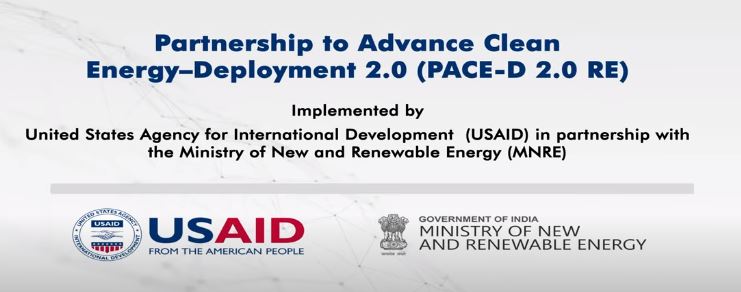 |
Title: Animated Video of Success Stories of PACE-D 2.0 RE Program (2019-2021) The program delivered several innovative and state-of-the-art solutions to enable the achievement of RE targets reliably and cost-effectively. The animation showcases the program components, key activities, and outcomes. Link to view: https://tinyurl.com/zsxbptkp |
 |
Title: DISCOM Renewable Procurement Optimization and Smart Estimation (DISCOM REPOSE) software tool About DISCOM REPOSE: DISCOM Renewable Energy Procurement Optimization and Smart Estimation (REPOSE) is a resource planning software that comes with a comprehensive set of advanced and scientific demand forecast methods, integrated resource mapping models, and power procurement optimization techniques built into three modules. This software helps distribution companies (DISCOMs) forecast profile-based demand, establish resource plans, and optimize future procurement costs. REPOSE provides utilities with hourly, weekly, and yearly visualizations of demand and resource adequacy (type, amount, and time) over a long-term and medium-term horizon up to the next ten years. Link to download DISCOM REPOSE: https://www.pace-d.com/DISCOM-REPOSE |
 |
Title: Accelerating Use of Renewable Energy by Green Time of Day Tariff Synopsis: The paper suggests several demand-side interventions such as demand generation, demand shift, electrical vehicle charging, storage before and after the meter, change in retail tariff design, and smart devices to remotely control the operation of electric home appliances, water pumps, etc. |
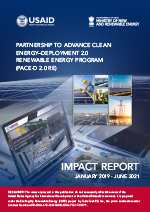 |
Title: PACE-D 2.0 RE Impact Report (January 2019 – June 2021) Synopsis: The report captures the results of the PACE-D 2.0 RE program in improving the strategic planning for renewable energy by the utilities, addressing core issues to scaling rooftop solar, and introducing innovative business models and system-friendly procurement practices. |
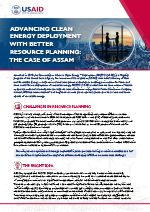 |
Title: Advancing Clean Energy Deployment with Better Resource Planning: The Case of Assam Synopsis: PACE-D 2.0 RE worked with the Government of Assam to develop tools and methods that can help the state distribution utility, Assam Power Distribution Company Limited (APDCL), create medium- and long-term resource plans, optimize power purchase costs, and boost uptake of renewable energy. |
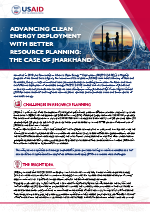 |
Title: Advancing Clean Energy Deployment with Better Resource Planning: The Case of Jharkhand Synopsis: PACE-D 2.0 RE worked with the Government of Jharkhand to develop tools and methods that can help the state distribution utility, Jharkhand Bijli Vitran Nigam Limited (JBVNL), create medium- and long-term resource plans, optimize power purchase costs, and boost uptake of renewable energy. |
 |
Title: Accelerating Solar Rooftop for Residential Customers Synopsis: The objective of this paper is to examine the challenges and make recommendations for accelerating the deployment of SPVRT among residential customers, where the greatest potential for rooftop solar expansion lies. The USAID PACE-D 2.0 RE team studied the prevailing self-owned, third party–owned, and DISCOM-owned business models and used the international experience of California, Australia, and Japan to innovate the Super Renewable Energy Service Company (RESCO) model to overcome the various challenges faced by LPC, RESCOs, and DISCOMs in large-scale solar rooftop adoption in the residential sector. |
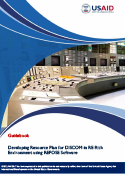 |
Title: Guidebook-Developing Resource Plan for DISCOM in RE Rich Environment using REPOSE Software Synopsis: The objective of the guidebook is to help utility professionals understand the importance of resource planning and how to formulate resource plans using the DISCOM REPSOE software tool. It covers essential topics under resource planning such as demand forecasting, generation resource mapping, and, finally, power procurement optimization. |
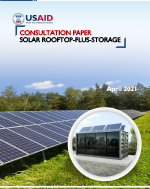 |
Title: Consultation Paper – Solar Rooftop-Plus-Storage Synopsis: The recent Gujarat Solar Power Policy 2021 introduces changes that impact the economic viability for solar-plus-storage for some consumers, which is discussed in the consultation paper. |
 |
Title: Deploying Solar PV Rooftop on Low-Paying Consumers’ Premises in Jharkhand Synopsis: For implementing the Super RESCO model under gross metering arrangement, JBVNL has received the approval from the competent authorities to execute the pilot in the State with support from the PACE-D 2.0 RE Program. This report lists the activities PACE-D 2.0 RE has already completed in Jharkhand and suggests a path to successfully implement the pilot. |
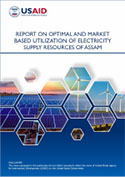 |
Title: Report on Optimal and Market Based Utilization of Electricity Supply Resources of Assam Synopsis: USAID PACE-D 2.0 RE investigated and analyzed the existing supply side resources, their operation, capacity, tariff, supply and demand pattern, import and export from power exchange (IEX). The supply and the demand data for the FY 2019-20 was collected and analysed in an interval of 15 minutes. The objective of this study is to examine the scope for optimization in the operation of the existing supply side resources of Assam Power Distribution Company Limited (APDCL). |
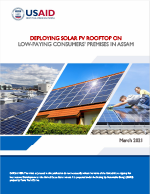 |
Title: Deploying Solar PV Rooftop on Low-Paying Consumers’ Premises in Assam Synopsis: This report suggests that Assam Power Distribution Company Ltd. pilot the deployment of solar PV rooftop using the Super RESCO model before rolling it out across Assam. The pilot and launch should target areas where AT&C losses are 30 percent or more to produce higher financial gains. Of the 46 APDCL divisions studied by the team, nine have AT&C losses of more than 30 percent. This report lists the activities PACE-D 2.0 RE has already completed in Assam and suggests a path to successfully implement the pilot. |
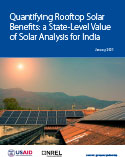 |
Title: Quantifying Rooftop Solar Benefits: A State-Level Value of Solar Analysis for India Synopsis: This report provides a value of solar analysis for two states in India: Gujarat and Jharkhand. With NREL, PACE-D 2.0 RE program analyzed the value of solar tariffs to quantify the net impact of rooftop solar on DISCOMs and ratepayers in Gujarat and Jharkhand. Policymakers, regulators, and other stakeholders can use the analysis to determine whether to adjust compensation mechanisms for rooftop solar considering concerns around cost-shifting between customers who do and do not adopt the systems. This data-driven approach could drive adoption where it is most beneficial and maintain deployment without exacerbating cost-shifting. The program presented its results to the electricity regulatory commissions in the two states last quarter and developed a simplified PLEXOS model to help Jharkhand determine the optimal solar tariff. |
 |
Title: DISCOM Renewable Energy Procurement Optimization & Smart Estimation Software Tool (DISCOM REPOSE) User Manual Synopsis: The user manual provides step-by-step guidance on how to perform end to end demand forecasting, integrated resource mapping and power procurement optimization using the modules in the software. |
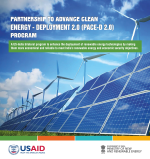 |
Title: PACE-D 2.0 RE Annual Report 2020 Synopsis: The Annual Report 2020 highlights the innovative concepts for Indian distribution utilities on strategic renewable energy planning, catalyzing grid-connected distributed PV, and system friendly procurement practices for renewable energy. |
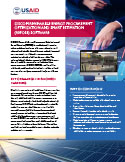 |
Title: DISCOM Renewable Energy Procurement Optimization and Smart Estimation (REPOSE) Software Synopsis: The brochure provides an overview of the DISCOM REPOSE software tool, the methodology adopted, and finally, the outputs generated by the software tool. It explains how the software tool will help the distribution companies (DISCOMs) cater to resource planning challenges and develop optimized power procurement plans. |
 |
Title: Demand Forecasting, Resource Mapping and Power Procurement Optimization Factsheet Synopsis: The Demand Forecasting, Resource Mapping and Power Procurement Optimization Factsheet highlights the overview of demand forecasting, resource mapping, and power procurement optimization under strategic energy planning for distribution companies (DISCOMs). It explains how efficient strategic energy planning will help the DISCOMs in reducing power purchase cost and simultaneously increase the uptake of renewable energy. |
 |
Title: Vendor Rating Framework – Experience from the Pilot Synopsis: The report will benchmark various rooftop solar (distributed solar) engineering, procurement and construction companies (EPCs or vendors) on a uniform set of parameters, which will provide a sense of the quality of the work carried out by these firms. The framework assesses companies on financial and technical capabilities and majorly on quality and safety of actual systems deployed on sites. The goal of developing this framework is to improve the quality of installations across the country and help customers and users make an informed choice of the vendors that they choose for their solar PV systems. |
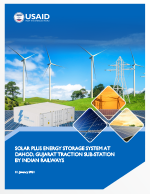 |
Title: Solar Plus Energy Storage System at Dahod, Gujarat Traction Sub-station by Indian Railways Synopsis: This note examines the technical, financial, and economic viability of replacing electricity supplied by the DISCOM-by solar power, expected per kWh electricity cost to Indian Railways (IR), and percentage replacement of DISCOM power at the various capacity of energy storage system (ESS), at the Dahod site near Ahmedabad. |
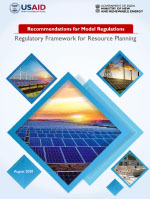 |
Title: Recommendations for Model Regulations: Regulatory Framework for Resource Planning Synopsis: To develop the model regulations, an extensive primary and secondary research was conducted for 12 states in India. Primary and secondary research reveals notable gaps that exist in the current regulatory framework for resource planning. These gaps are related to the very existence of regulatory framework for resource planning, the methodology adopted, importance to RE in power portfolios, and the availability of trained staff to formulate the resource plans. |
 |
Title: Solar Energy Corporation of India Launches Second Tranche of System-Friendly RE Procurement Synopsis: The Solar Energy Corporation of India (SECI) releases two system-friendly renewable energy procurements that lower generation and integration costs—major milestones in the country’s transition to a renewable energy future. The SECI tenders incorporated several lessons and global best practices on system-friendly competitive bidding provided by USAID’s Partnership to Advance Clean Energy Deployment(link is external) (PACE-D 2.0 RE) program. |
 |
Synopsis: This report has been prepared by the National Renewable Energy Laboratory (NREL) with support from the U.S. Agency for International Development (USAID) for discussion purposes with a broad range of stakeholders. These include Indian regulatory agencies (such as the Forum of Regulators, the Central Electricity Regulatory Commission, and various State Electricity Regulatory Commissions), policy makers, utilities, and developers to inform a broader dialogue around the future direction of Indian states’ approach to regulating and facilitating DPV-plus-storage systems. |
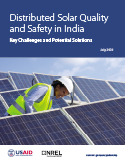 |
Title:Distributed Solar Quality and Safety in India: Key Challenges and Potential Solutions Synopsis: This report presents a series of best practices and priorities for use by concerned authorities in India to improve the quality and safety of rooftop photovoltaic systems. Prepared under the USAID-NREL Partnership, and in collaboration with USAID-India’s Partnership to Advance Clean Energy Development (PACE-D) 2.0, this report uses primary and secondary resources to help understand the current state of solar quality and safety in India and to provide the basis for future recommendations. |
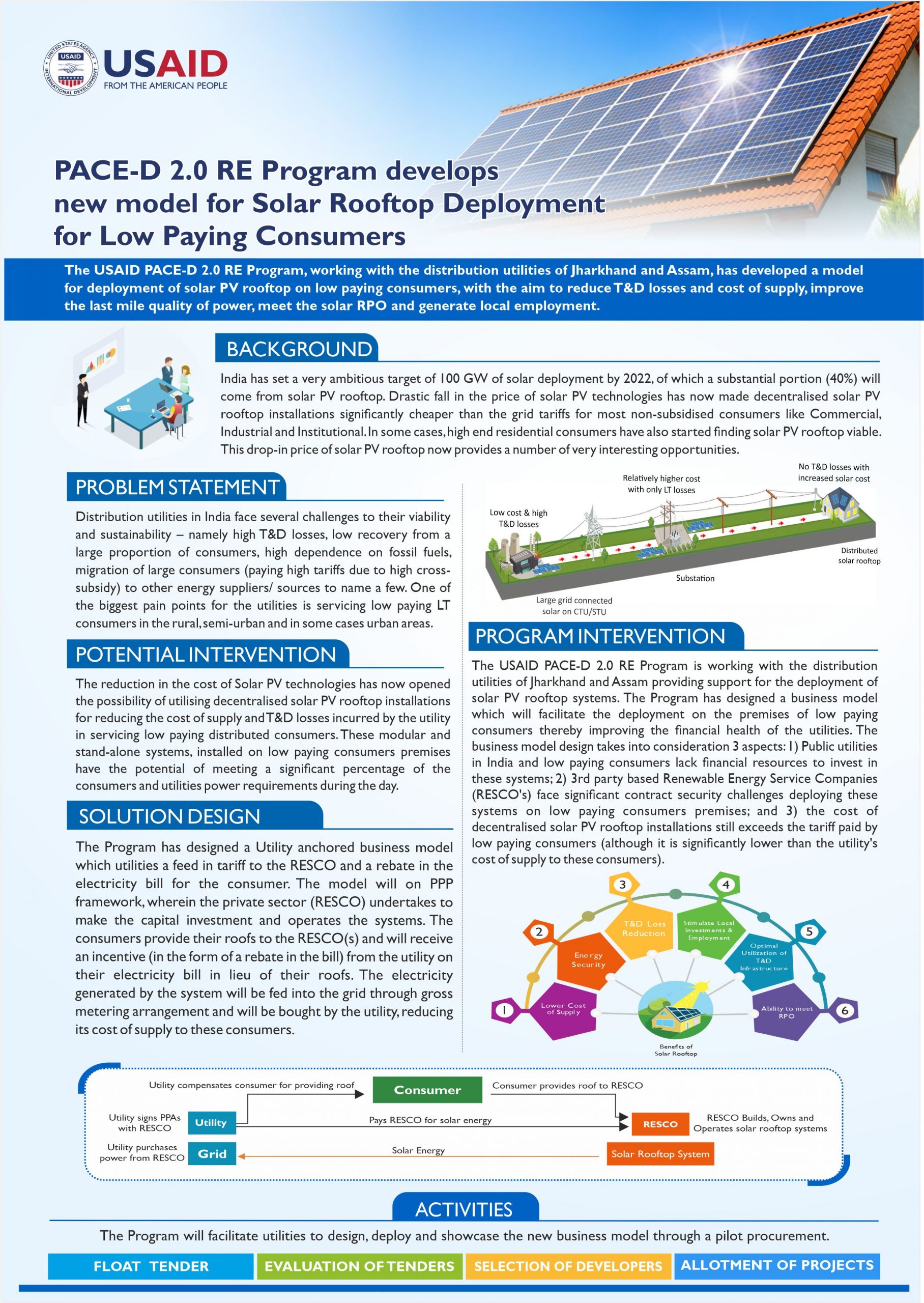 |
Title: New Model for Solar Rooftop Deployment for Low Paying Consumers Synopsis: The PACE-D 2.0 RE program worked with the DISCOMs of Assam and Jharkhand. The program has developed a model for deployment of solar PV rooftop on low paying consumers, with the aim to reduce T&D losses and cost of supply, improve the last mile quality of power, meet the solar RPO, and generate local employment. |
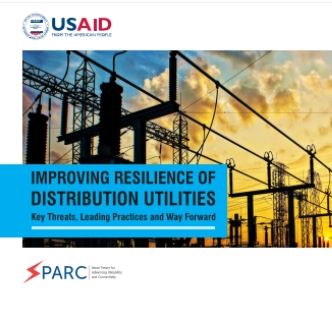 |
Title: Improving the Quality and Safety of Solar PV Systems in India Synopsis: The brochure provides an overview of implementing a framework for enhancing DPV quality and safety for India. |
 |
Title: Value of Solar Analysis for Jharkhand Synopsis: PACE-D 2.0 RE and NREL team conducted the value of solar (VoS) analysis for the state of Jharkhand. After a complex modelling developed a simplified model for the state regulator of Jharkhand to use more frequently in tuning the RE tariff in the state. The VoS analysis seeks to calculate the net benefits and costs distributed PV (DPV) provides to the power system. |
 |
Synopsis: Indian Railways (IR) is 2nd largest rail network in the world, carries the most passengers in the world, is the 9th largest employer in the world, employing 1.6 million people and not surprisingly is an energy guzzler. Haryana, is a small state by IR electricity demand requirements, hits its peaks between 5:30 AM – 10: 00 AM in the morning and then between 5:30 PM – 10:00 PM in the evening. This creates some challenges in the procurement of RE. The initial aim of the Program was to evaluate whether a state could be converted into a completely RE (Green) Powered Zone – we tried doing this with Haryana – leading to quire outrageous results. |
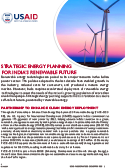 |
Title:Strategic Energy Planning for India’s Future Synopsis: This fact sheet highlights how strategic energy planning will support India’s transition to a more self-reliant future, powered by renewable energy. PACE-D 2.0 RE program and the Ministry of New and Renewable Energy (MNRE) has developed a new energy planning approach for India that has a more comprehensive methodology and optimizes procurement with renewable energy options that are cheaper, cleaner, and require less time to commission. |
 |
Title: A Modernized Approach for Energy Demand Forecasting Synopsis: This fact sheet provides a quick look at the Demand Forecasting Software, a state-of-the-art tool developed by USAID’s Partnership to Advance Clean Energy Deployment (PACE -D 2.0 RE) program to help distribution companies optimize power procurements with renewable energy options. |
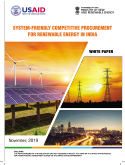 |
Title: White Paper on System-Friendly Competitive Procurement for Renewable Energy in India Synopsis: The paper captures global experiences in successful large-scale RE procurement designs such as time-based incentives and penalties, aggregates or virtual hybrids, procurement of (physical) hybrid solutions and locational signals. The paper also highlights the challenges surrounding RE procurement in India and offers suggestions for the way forward. |
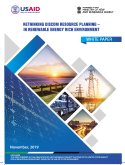 |
Title: White Paper on Rethinking DISCOM Resource Planning – in Renewable Energy Rich Environment Synopsis: This paper seeks to encourage DISCOMs, policymakers and other stakeholders to rethink their current method of resource planning. It analyzes the current state of resource planning, draws lessons from renewable energy-rich countries (USA, Australia, Germany, UK and others), and makes recommendations to improve resource planning at DISCOMs so they can move from a fossil-fuel based power portfolio to an RE-based portfolio. |
 |
Synopsis: The brochure provides an overview of the PACE-D 2.0 RE program, its components, approach and outcomes. |
 |
Title: Partnership to Advance Clean Energy Deployment (PACE-D 2.0) Technical Assistance Program Synopsis: Overview of the PACE-D 2.0 TA Program, it’s components and activities. |
 |
Synopsis: Brochure providing an overview of the PACE-D TA Program key activities and impact. |
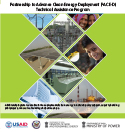 |
Synopsis: Brochure providing an overview of the PACE-D TA Program key activities, partners and overall outcomes. |
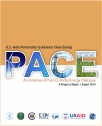 |
Title: PACE Annual Progress Report Synopsis: Annual progress report on the U.S.-India Partnership to Advance Clean Energy (PACE) providing highlights of the key activities for the period October 2015 – August 2016. |
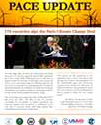 |
Synopsis: Quarterly newsletter on the U.S.-India Partnership to Advance Clean Energy (PACE) providing highlights of the key activities for the period January – April 2016. |
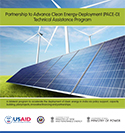 |
Synopsis: Brochure providing an overview of the PACE-D TA Program components, and key activities and outcomes. |
 |
Synopsis: Quarterly newsletter on the U.S.-India Partnership to Advance Clean Energy (PACE) providing highlights of the key activities for the period September – December 2015. |
 |
Title: Institutional Strengthening in Focal States Synopsis: Brochure on the key interventions undertaken by the Program in the four focal states – Haryana, Karnataka, Madhya Pradesh and Rajasthan. |
 |
Title: PACE Annual Progress Report Synopsis: Annual progress report on the U.S.-India Partnership to Advance Clean Energy (PACE) providing highlights of the key activities for the period August 2014 – September 2015. |
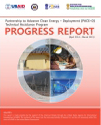 |
Title: PACE-D Annual Progress Report Synopsis: Annual report on the PACE-D TA Program providing highlights of key activities for April 2014 – March 2015. |
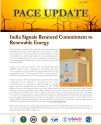 |
Synopsis: Newsletter on the U.S.-India Partnership to Advance Clean Energy (PACE) providing highlights of key activities in India for the period March 2015 – June 2015. |
 |
Synopsis: Newsletter on the U.S.-India Partnership to Advance Clean Energy (PACE) providing highlights of key activities in India for the period November 2014 – January 2015. |
 |
Synopsis: Brochure providing an overview of the PACE-D TA Program components and key activities. Resource Type: Brochure |
 |
Synopsis: Newsletter on the U.S.-India Partnership to Advance Clean Energy (PACE) providing highlights of key activities in India for the period August-October 2014. |
 |
Title: PACE Brochure: The Power of Partnership Synopsis: Brochure providing an overview of the Partnership to Advance Clean Energy (PACE) initiative including key highlights since inception in November 2009. |
 |
Title: PACE: A Progress Report Synopsis: Annual progress report on the U.S.-India Partnership to Advance Clean Energy (PACE) providing highlights of the key activities for the period June 2013 – July 2014. |
 |
Synopsis: Newsletter on the U.S.-India Partnership to Advance Clean Energy (PACE) providing highlights of key activities in India. |
 |
Title: PACE-D TA Program Brochure: Clean Energy Finance Synopsis: One page overview of the PACE-D TA Program’s activities on finance for energy efficiency and renewable energy projects. |
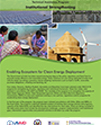 |
Title: PACE-D TA Program Brochure: Institutional Strengthening Synopsis: One page overview of the PACE-D TA Program’s activities on institutional strengthening in focal states of Haryana, Madhya Pradesh, Karnataka and Rajasthan. |
 |
Title: PACE-D TA Program Briefer Synopsis: One page overview of the PACE-D TA Program providing information on key activities and implementation team. |
 |
Synopsis: Newsletter on the U.S.-India Partnership to Advance Clean Energy (PACE) providing highlights of key activities in India. |
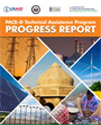 |
Synopsis: Annual report on the PACE-D TA Program providing highlights of key activities since its launch. |
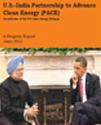 |
Title: U.S.-India Partnership to Advance Clean Energy (PACE): A Progress Report Synopsis: Progress report on U.S.-India Partnership to Advance Clean Energy (PACE) and key highlights of the PACE-R and PACE-D programs. |
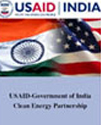 |
Title: USAID-Government of India Clean Energy Partnership Synopsis: Overview of USAID’s energy programs in India and details of PACE-D Technical Assistance Contract including implementation consortium. |
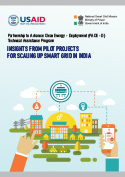 |
Title: Insights from Pilot Projects for Scaling up Smart Grid in India Synopsis:The USAID PACE-D TA Program, under the guidance of National Smart Grid Mission, analyzed the experience of select Smart Grid pilot projects in India and subsequently collated the key learnings. This report documents the insights which would help the stakeholders in avoiding implementation bottleneck and improving project efficiency. |
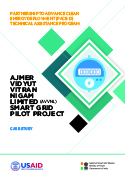 |
Title: AVVNL Smart Grid Pilot Project Case Study Synopsis:The USAID PACE-D TA Program assisted Ajmer Vidyut Vitran Nigam Ltd. (AVVNL) to demonstrate the benefits of select Smart Grid functionalities on a pilot basis. This case study provides an overview of the pilot program and the key outcomes and learning. |
 |
Title: Smart Grid – Towards an Intelligent Future Synopsis:This report provides a consolidated overview of the various Smart Grid interventions undertaken by the PACE-D TA Program. It includes: Model Regulations, Pilot Projects, Capacity Building and support for the Implementation Framework for the National Smart Grid Mission. |
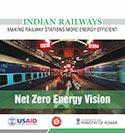 |
Title: Indian Railways: Making Railway Stations More Energy Efficient Synopsis:The USAID PACE-D TA Program provided support to Indian Railways to develop a net zero energy vision for 400 stations. This brochure provides an overview of the key interventions and learnings. |
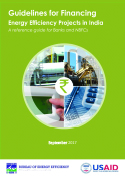 |
Title: Guidelines for Financing Energy Efficiency Projects in India Synopsis:The Guidelines, developed by the USAID’s PACE-D TA Program in partnership with the Bureau of Energy Efficiency (BEE), aim to assist financial institutions to understand the nuances of energy efficiency financing and make informed credit decisions. |
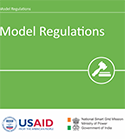 |
Synopsis: The brochure provides an overview of the technical assistance provided by the PACE-D TA Program to develop model Smart Grid regulations. |
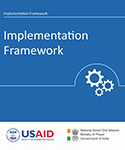 |
Title: Implementation Framework Synopsis: The brochure provides an overview of the technical assistance provided by the PACE-D TA Program to the National Smart Grid Mission to develop implementation Framework which includes roles, goals, processes, long term roadmap, immediate priorities, business model, etc. |
 |
Title: Capacity Building & Training Synopsis: The brochure provides an overview of the basic Smart Grid course for utility personnel developed by the PACE-D TA Program in collaboration with the National Smart Grid Mission. |
 |
Synopsis: The brochure provides an overview of the two Smart Grid pilot projects (Ajmer and Tripura) supported by the USAID PACE-D TA Program. |
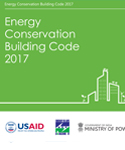 |
Title: Energy Conservation Building Code 2017 Brochure Synopsis:The brochure provides an overview of the technical update of ECBC 2017, the new features and key impact. |
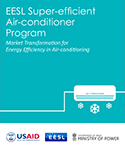 |
Title: EESL Super-efficient Air-conditioner Program Brochure Synopsis:The brochure provides an overview of the technical assistance provided by the PACE-D TA Program to EESL on the market transformation activities for super-efficient air-conditioners. |
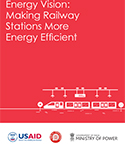 |
Title: Net Zero Energy Vision for Railway Stations Brochure Synopsis:The brochure provides an overview of the technical assistance provided by the PACE-D TA Program to Indian Railways to make railway stations energy efficient. |
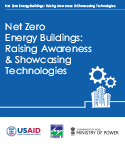 |
Title: Net Zero Energy Awareness & Pilot Brochure Synopsis: The brochure provides an overview of the NZEB knowledge portal developed by the PACE-D TA Program and the pilot project with Nalanda University. |
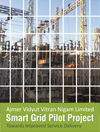 |
Title: Smart Grid Pilot Project in Ajmer Synopsis:The brochure provides an overview of the Smart Grid pilot project implemented in Ajmer in partnership between PACE-D TA Program, National Smart Grid Mission and Ajmer Vidyut Vitran Nigam Ltd. |
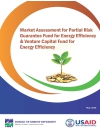 |
Title: Market Assessment for PRGFEE and VCFEE Synopsis:The PACE-D TA Program, in partnership with the Alliance for an Energy Efficient Economy, carried out a market study to determine the potential pipeline of energy efficiency (EE) projects for the Bureau of Energy Efficiency’s two financing instruments – Partial Risk Guarantee Fund for EE (PRGFEE) and the Venture Capital Fund for EE (VCFEE). The report presents the findings of the study and recommendations based on the findings. |
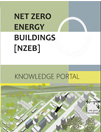 |
Title: Net Zero Energy Buildings Brochure Synopsis:The brochure provides an overview of the knowledge portal on Net Zero Energy Buildings ( www.nzeb.in ) developed by the PACE-D TA Program. |
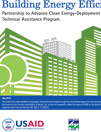 |
Title: Buildings Energy Efficiency Brochure Synopsis:The brochure provides highlights of the key activities done under the Buildings Energy Efficiency component of the PACE-D TA Program. These include: Energy Conservation Building Code (ECBC), Net Zero Energy Buildings, and Heating, Ventilation and Air-conditioning. |
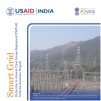 |
Synopsis:The brochure provides an overview of the Smart Grid interventions under the PACE-D TA Program. These include: technical reports, training, pilot programs and an awareness film. |
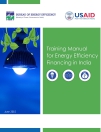 |
Title: Training Manual for Energy Efficiency Financing in India Synopsis:The manual, developed by the USAID PACE-D TA Program in collaboration with the Bureau of Energy Efficiency, aims to help financial institutions to understand the associated benefits, risks and financing issues of energy efficiency projects. The manual focuses on: a) market opportunity and business models for energy efficiency projects; b) project appraisal – technical and financial; and c) measurement and verification: international best practices and case studies. |
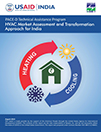 |
Title: HVAC Market Assessment and Transformation Approach for India Synopsis:The report developed by the PACE-D TA Program presents the findings of the market research done to identify existing barriers to implementation of HVAC technologies in India. It also suggests market transformation approach to accelerate the HVAC market. |
 |
Title: PACE-D TA Program Brochure: Smart Grids Synopsis:One page overview of the PACE-D TA Program’s activities on smart grid including regulatory framework, capacity building and pliot projects. |
 |
Title: PACE-D TA Program Brochure: Industrial Energy Efficiency Synopsis:One page overview of the PACE-D TA Program’s activities on low grade waste heat utilization. |
 |
Title: PACE-D TA Program Brochure: Building Energy Efficiency Synopsis: One page overview of the PACE-D TA Program’s activities on Net Zero Energy Buildings and Heating, Ventilation and Air-conditioning (HVAC). |
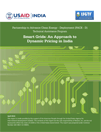 |
Title: Smart Grids: An Approach to Dynamic Pricing in India Synopsis: The report, developed by USAID’s PACE-D TA Program, develops an approach to dynamic pricing in support of the Ministry of Power’s initiative for smart grid pilot projects in India. Dynamic pricing experiments are intended to reveal how consumers respond to electricity prices and identify the most promising mechanisms suitable for wide-scale deployment. |
 |
Title: Smart Grids: A Roadmap for Communication and Application Interoperability in India Synopsis: The report, developed by USAID’s PACE-D TA Program, compiles, analyses, and refines the different approaches to interoperability and standardization in the field of power distribution networks. It defines an analysis framework or “Interoperability Matrix”, and uses this to categorize and compare the different existing approaches. |
 |
Title: Financing Energy Efficiency in India Synopsis: The report, developed under the PACE-D TA Program, focuses on efforts to overcome the existing barriers to financing of energy efficiency projects in India. It reviews and documents recent Indian experience in establishing and using financial instruments for energy efficiency; and presents recommendations for the development and piloting of seven innovative financing mechanisms. |
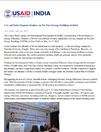 |
Title: USAID Press Release – NZEB workshop Synopsis: The United States Agency for International Development (USAID), in partnership with the Bureau of Energy Efficiency, Ministry of Power, Government of India, organized a two-day seminar on Net Zero Energy Buildings (NZEBs) in New Delhi on May 16-17, 2013. |
 |
Title: Smart Grids Electric System Inception Report Synopsis: The inception reports provides an overview of the smart grid vision for India, the institutional set up, existing initiatives and lessons learnt. It also defines the priority areas for smart grid activities under the USAID PACE-D TA Program. |
 |
Title: PACE-D TA Program Brochure: Cleaner Fossil Technologies Synopsis:One page overview of the PACE-D TA Program’s activities on increasing the operational efficiency of power plants |
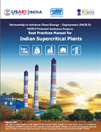 |
Title: Best Practices Manual for Indian Supercritical Plants Synopsis: The Best Practices Manual is a compilation of the lessons learned and the experience gained from operating supercritical thermal power plants in U.S. utilities. Information is provided under various chapters addressing four key areas of interest: current status of supercritical plants globally, reduction of GHG emissions, improved fleet reliability and workforce safety in the power sector.Click Here for an Abstract Data |

